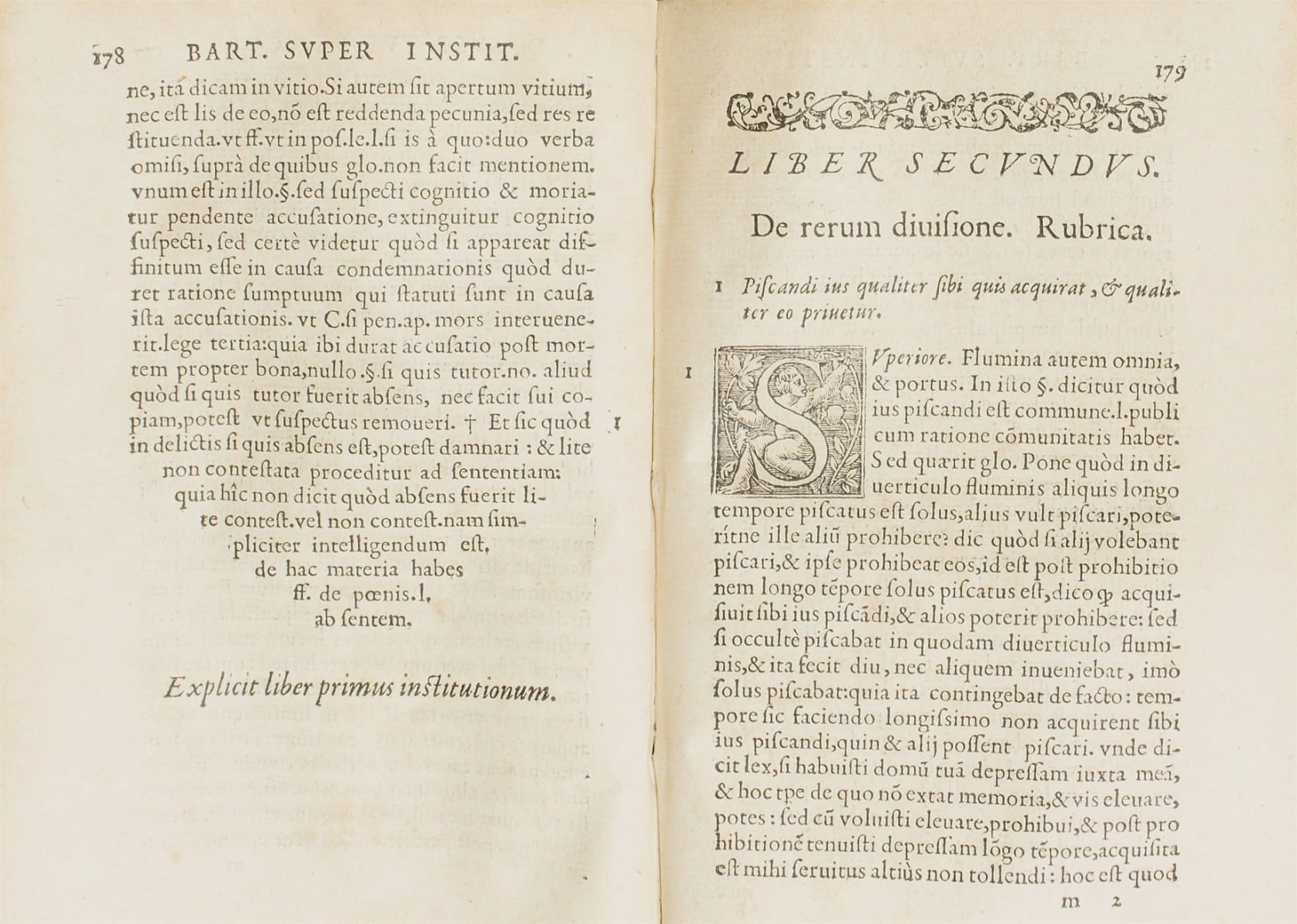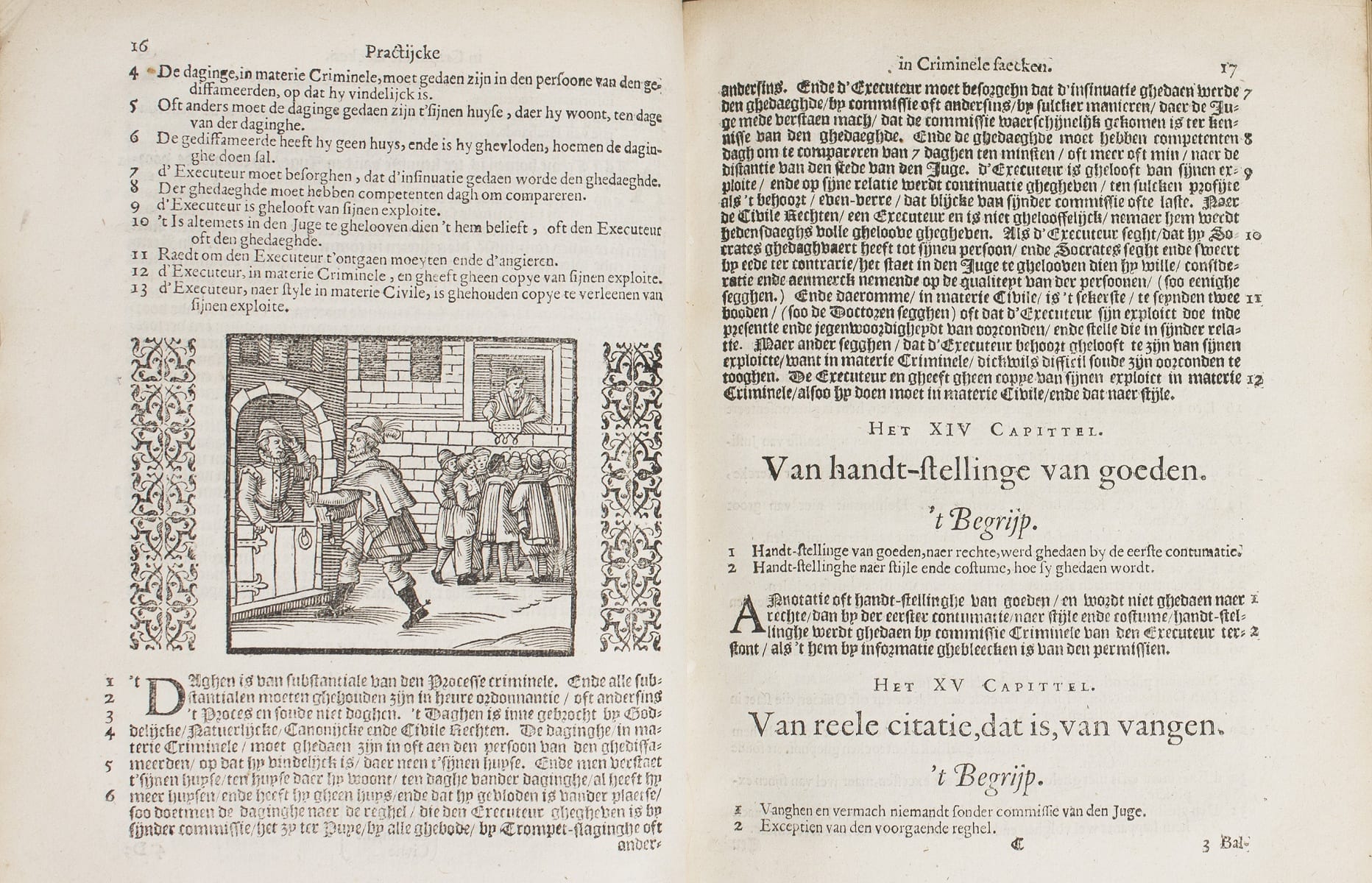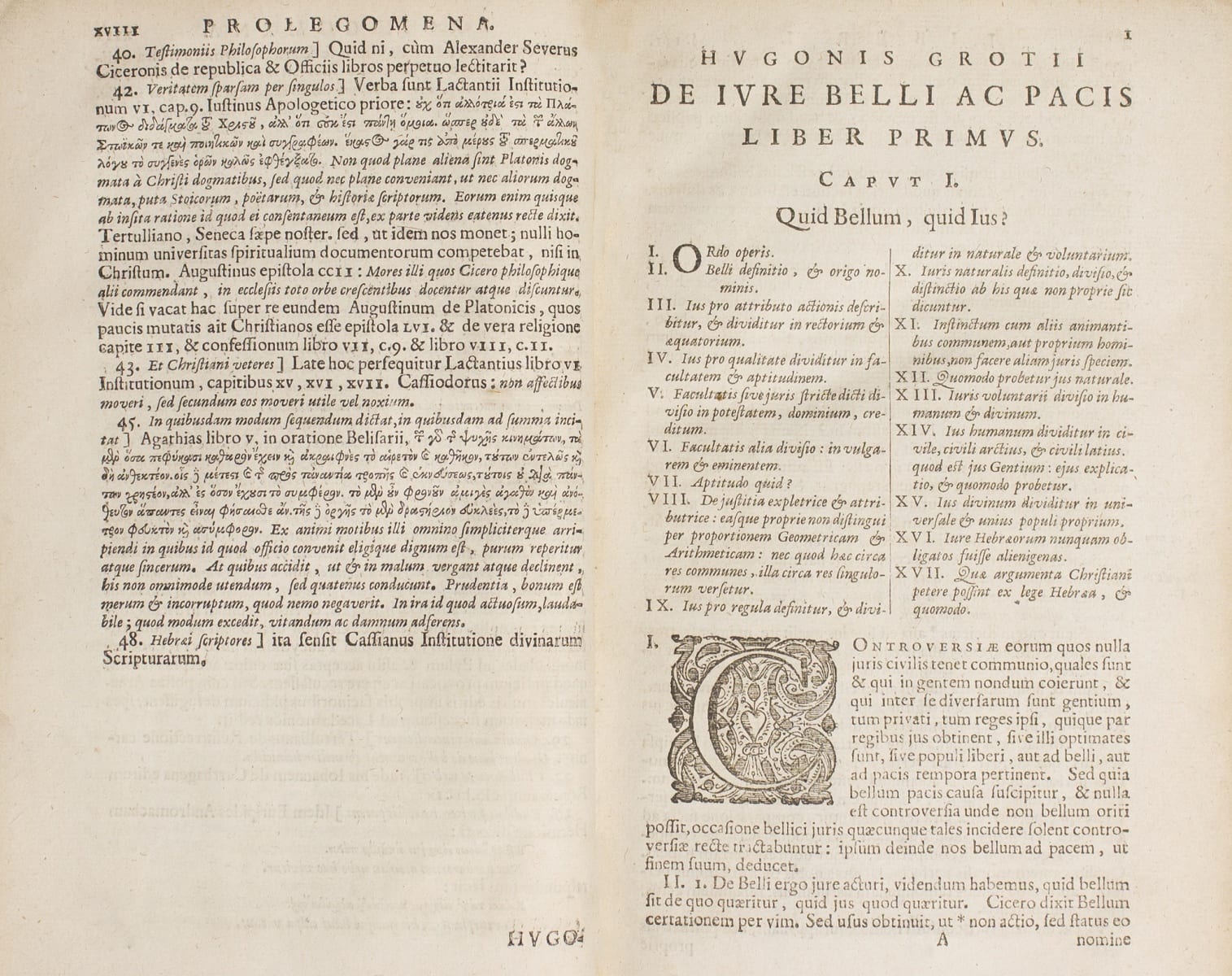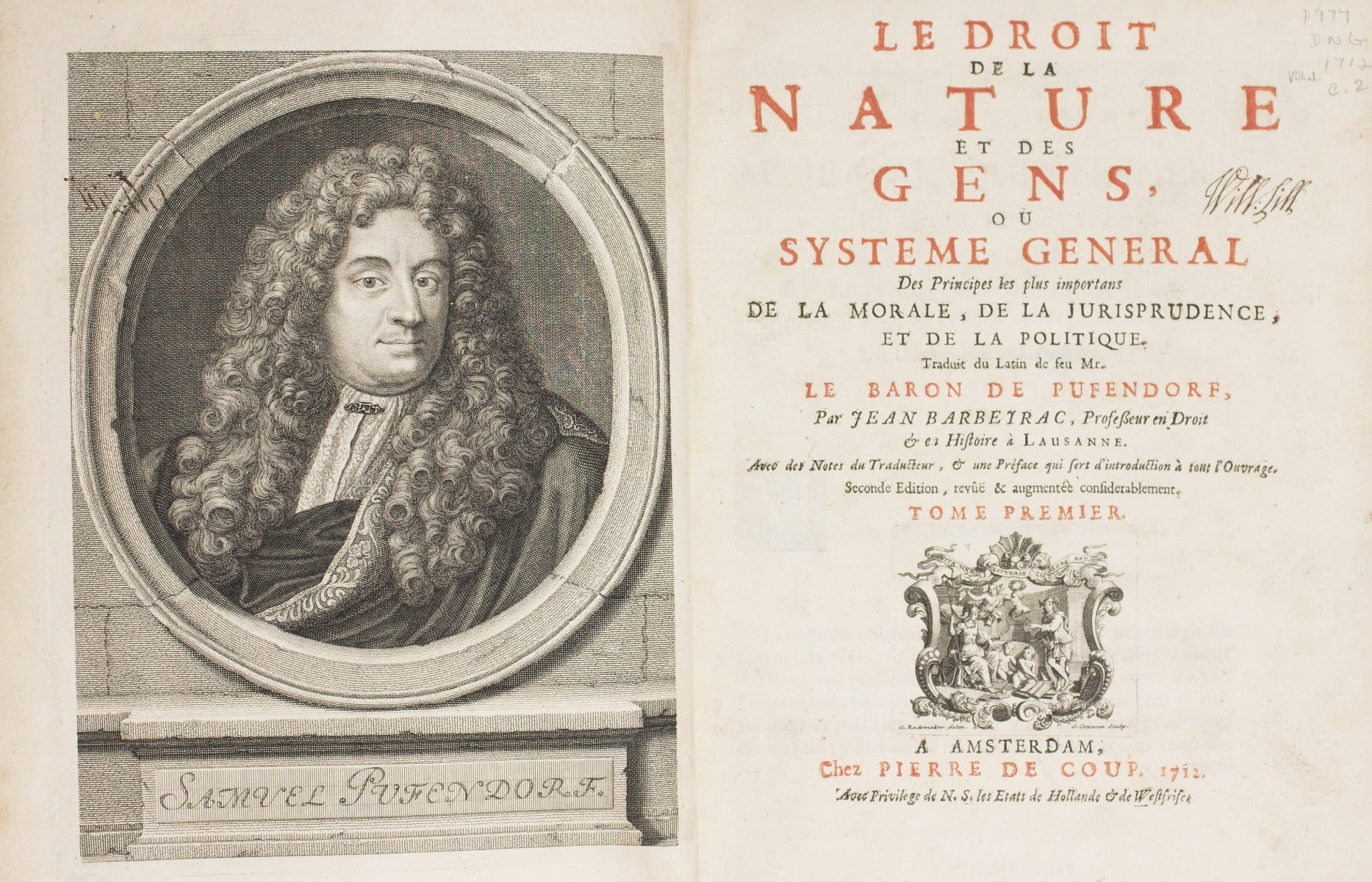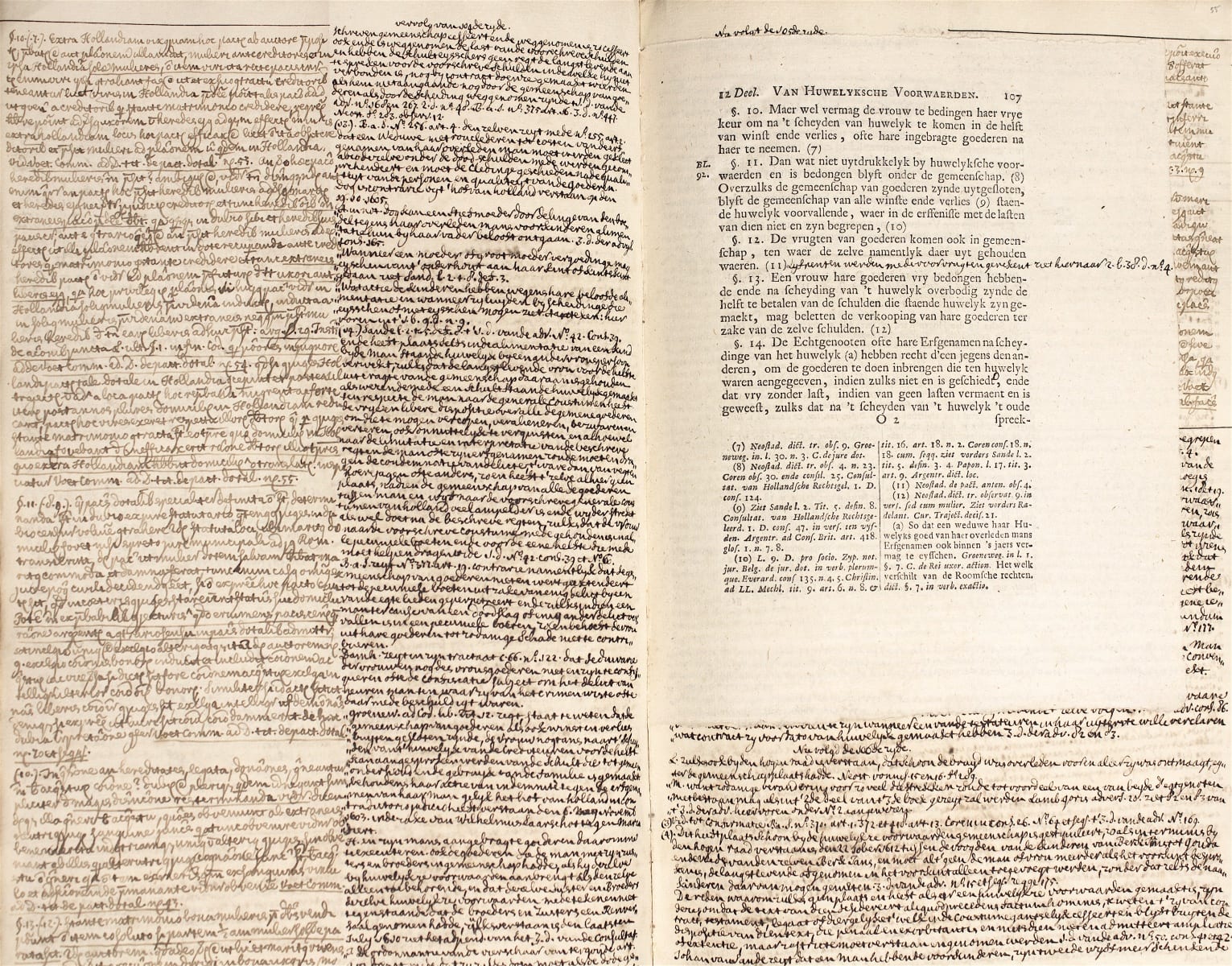January 19 – March 15, 2009
University of California, Berkeley School of Law
INTRODUCTION
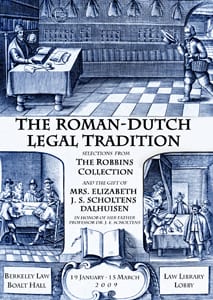 The rediscovery of Justinian’s compilation of Roman law by Italian jurists in the twelfth century launched a new legal scholarship in Europe. This new scholarship flourished and evolved into what was known as the ius commune, a shared legal tradition that combined Roman law and canon law into a common system of legal thought, inflected in each particular country or region by local law and custom. Reintroducing Justinian’s sixth-century Digest, Code, and Institutes to Europe as the Corpus iuris civilis, the Italians were the foremost scholars of Roman law until the French took over that role in the sixteenth century, when legal humanism refocused emphasis on the original sources and context of classical Roman law.
The rediscovery of Justinian’s compilation of Roman law by Italian jurists in the twelfth century launched a new legal scholarship in Europe. This new scholarship flourished and evolved into what was known as the ius commune, a shared legal tradition that combined Roman law and canon law into a common system of legal thought, inflected in each particular country or region by local law and custom. Reintroducing Justinian’s sixth-century Digest, Code, and Institutes to Europe as the Corpus iuris civilis, the Italians were the foremost scholars of Roman law until the French took over that role in the sixteenth century, when legal humanism refocused emphasis on the original sources and context of classical Roman law.
This new legal humanism culminated with the Dutch jurists of the seventeenth and eighteenth centuries, who brought new insight to the examination of the Roman sources while innovating approaches to the study and synthesis of local customary law within a classical Roman framework. The flowering of Dutch scholarship and its prominence in European legal culture went hand in hand with the expansion of Dutch economic and political power in Europe and abroad as it expanded trade throughout colonial territories in Africa and South Asia.
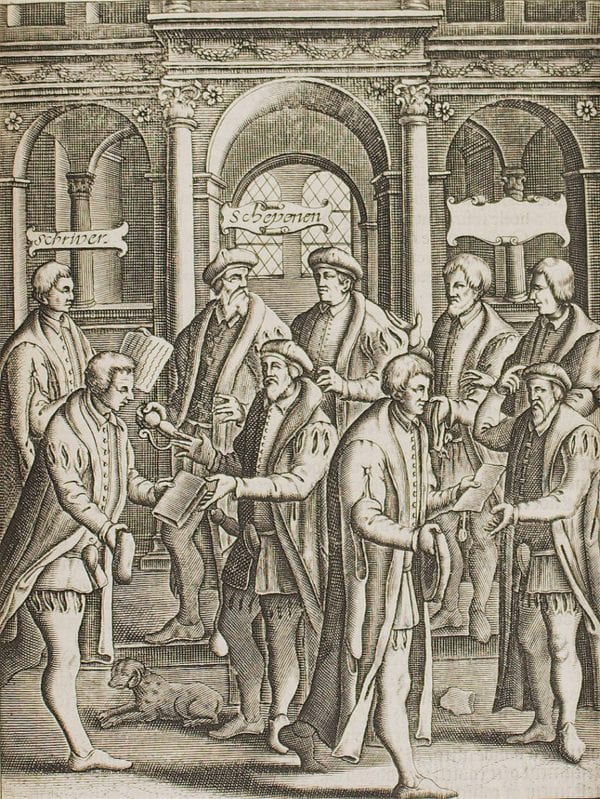 The Dutch system of law that was exported to its colonies was thus dominated by the Roman-Dutch tradition of the time. The codification of Dutch law based upon the French civil code replaced the early modern system in the Netherlands in 1809. Still, Roman-Dutch law has remained part of the legal systems of many other countries as they moved from Dutch to British colonial rule to independence. It continues to be a source of law to the present day, most significantly in South Africa and Sri Lanka, but also in Indonesia, Zimbabwe, Namibia, Swaziland, and Lesotho. The persistence in these countries of a civil law tradition based directly upon classical Roman law is a fascinating chapter in the evolution of modern law that preserves a link to the practice of law in ancient Rome.
The Dutch system of law that was exported to its colonies was thus dominated by the Roman-Dutch tradition of the time. The codification of Dutch law based upon the French civil code replaced the early modern system in the Netherlands in 1809. Still, Roman-Dutch law has remained part of the legal systems of many other countries as they moved from Dutch to British colonial rule to independence. It continues to be a source of law to the present day, most significantly in South Africa and Sri Lanka, but also in Indonesia, Zimbabwe, Namibia, Swaziland, and Lesotho. The persistence in these countries of a civil law tradition based directly upon classical Roman law is a fascinating chapter in the evolution of modern law that preserves a link to the practice of law in ancient Rome.
This exhibit highlights several rare volumes from the recent gift of Mrs. Elizabeth J.S. Scholtens Dalhuisen to the Robbins Collection Center in honor of her father, Professor J.E. Scholtens, former chair of Roman-Dutch law at the University of the Witwatersrand, Johannesburg, South Africa.
Image: Joost de Damhoudere, Practycke in criminele saken…, 1650.
ROMAN-DUTCH LEGAL TEXTS IN THE ROBBINS COLLECTION
Corpus iuris civilis.
(Lyon: Bartolomaeus Poncetus: 1562).
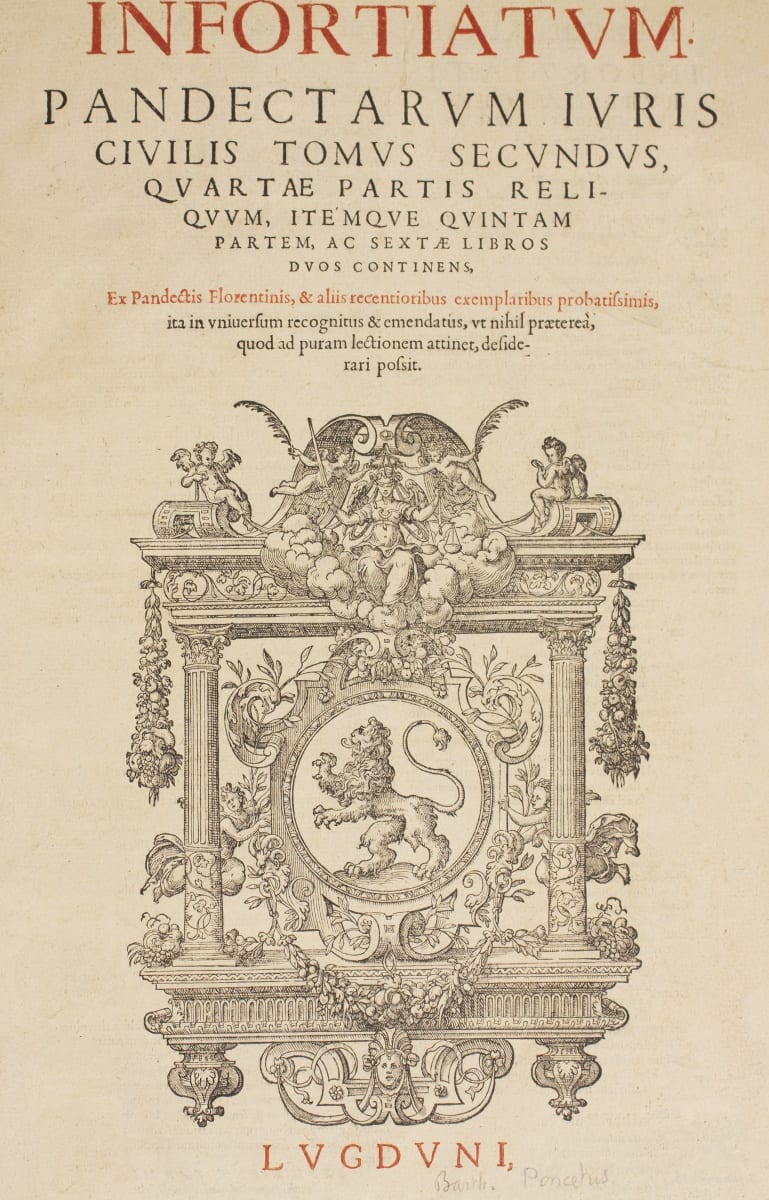 The Corpus iuris civilis, or Body of Civil Law, compiled by order of the Byzantine emperor Justinian between 529 and 34 C.E., became the foundational source for Roman law in the Western tradition. All later systems of law in the West borrowed from it, including the civil law systems of Western Europe, Latin America, and parts of Africa–and to a lesser but still notable extent, the English common law system. It consisted of three parts: the Digest, (Digesta or Pandectae) which collected and summarized all of the classical jurists’ writings on law and justice; the Code (Codex) outlined the actual laws of the empire, citing imperial constitutions, legislation and pronouncements; and the Institutes (Institutiones), a small work that summarized the Digest and was created as a textbook for law students.
The Corpus iuris civilis, or Body of Civil Law, compiled by order of the Byzantine emperor Justinian between 529 and 34 C.E., became the foundational source for Roman law in the Western tradition. All later systems of law in the West borrowed from it, including the civil law systems of Western Europe, Latin America, and parts of Africa–and to a lesser but still notable extent, the English common law system. It consisted of three parts: the Digest, (Digesta or Pandectae) which collected and summarized all of the classical jurists’ writings on law and justice; the Code (Codex) outlined the actual laws of the empire, citing imperial constitutions, legislation and pronouncements; and the Institutes (Institutiones), a small work that summarized the Digest and was created as a textbook for law students.
Institutiones iuris ciulis D. Iustiniani magni imperio per triumuiros Tribonianum, Dorotheum, ac Theophilum conscriptae…
(Lyon: Antonium Vincentium, 1557).
The Institutes, a summary of Justinian’s Digest, was originally created as a textbook for students of law. Because it was designed as a learning tool, it had the advantage of being part of the Corpus iuris civilis that was arranged in a rational order. The Institutiones was given new life by the French humanists who found that the work lent itself to their desire to recast civil law in a more systematic form. The most influential French humanist to study the institutes was Hugues Doneau, or Donellus, (1527-1591), who devoted himself to understanding Roman law’s underlying rational structure and paved the way for the study of civil law as a science.
Nicolaus Everardi. Loci argumentorum legales.
(Lyon: Iacobi Giuntae, 1556).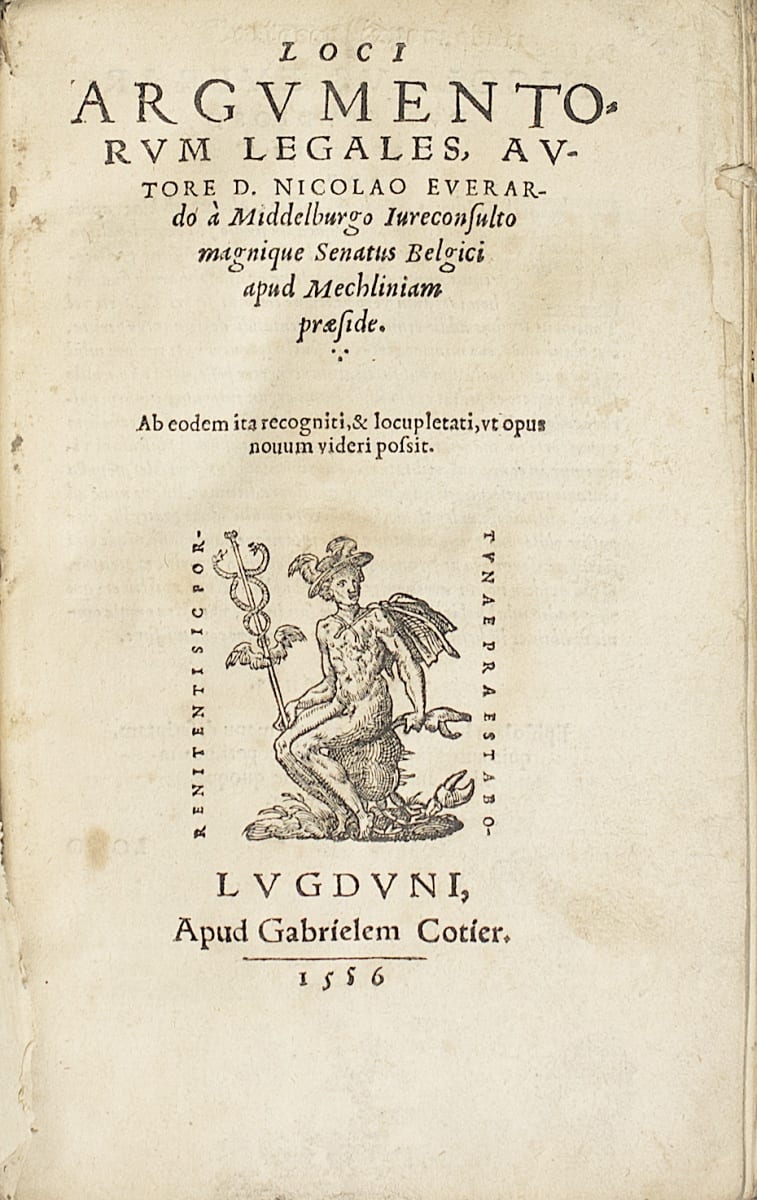
One of the earliest works in the Roman-Dutch tradition, Everardi’s Loci argumentorum legales was an important reference for future generations of legal scholars in the Netherlands and throughout Europe. Beginning his career in the 1490s, Everardi was a professor of civil and canon law at Louvain and an ecclesiastical judge. He later became President of the Supreme Court of Holland, Zeeland, and Friesland. Loci argumentorum legales, originally published in Lyon in 1516 and reprinted in numerous European editions throughout the sixteenth and seventeenth centuries, was innovative in its systematic analysis of the different kinds of legal argument, as well as its use of Roman law to frame and delineate arguments drawn from non-Roman law.
Bartolo of Sassoferrato. Dn. Bartoli de Saxoferrato iurisconsulti clarissimi super Instiutionibus iuruis ciuilis commentaria…
(Lyon: Iacobi Giuntae, 1559).
Bartolus (1313/4-57) was an Italian law professor and one of the most prominent continental jurists of the Middle Ages. He wrote exhaustive commentaries on all parts of the Corpus iuris civilis with an eminently practical approach. He sought not simply to understand the texts as they had been handed down, but to draw rules from them which would be applicable to the legal problems of the day. By drawing out a coherent rationale from the spare and often conflicting rulings of the Roman texts, Bartolus was able to establish rules that themselves had the force of law. His methods were illustrative of a school known as the Commentators, whose work began in Italy with Cinus of Pistoa as well as with the Decretalists working on canon law, and among the Orleans school in France. The work of the Commentators came to dominate the study of civil law during the fourteenth and fifteenth centuries.
Filippo Decio. Philippi Decii Mediolanensis Iuriscons. regiiq consiliarii praestantiss In primam ac secundam Digesti veteris partem doctissima commentaria…
(Venice: Officina Iuntarum, 1568).
Filippo Decio, or Decius, (1454-1536/7), was the most prominent and among the most prolific of the last generation of commentators following the tradition of Bartolus, which had come to be known as the mos italicus (the Italian method). While a law professor at Pavia, Decio taught Andrea Alciato, who went on to be the most influential jurist of a new generation of legal scholars. The new focus of the humanist tradition would be to disentangle the Roman texts from the glosses and commentaries not just to find applicable rules, but to discover the original meaning of Justinian’s texts and to reconstruct Roman political and social institutions. This method, embraced by the French humanists while Alciato was at Avignon, came to be known as the mos gallicus (the French method).
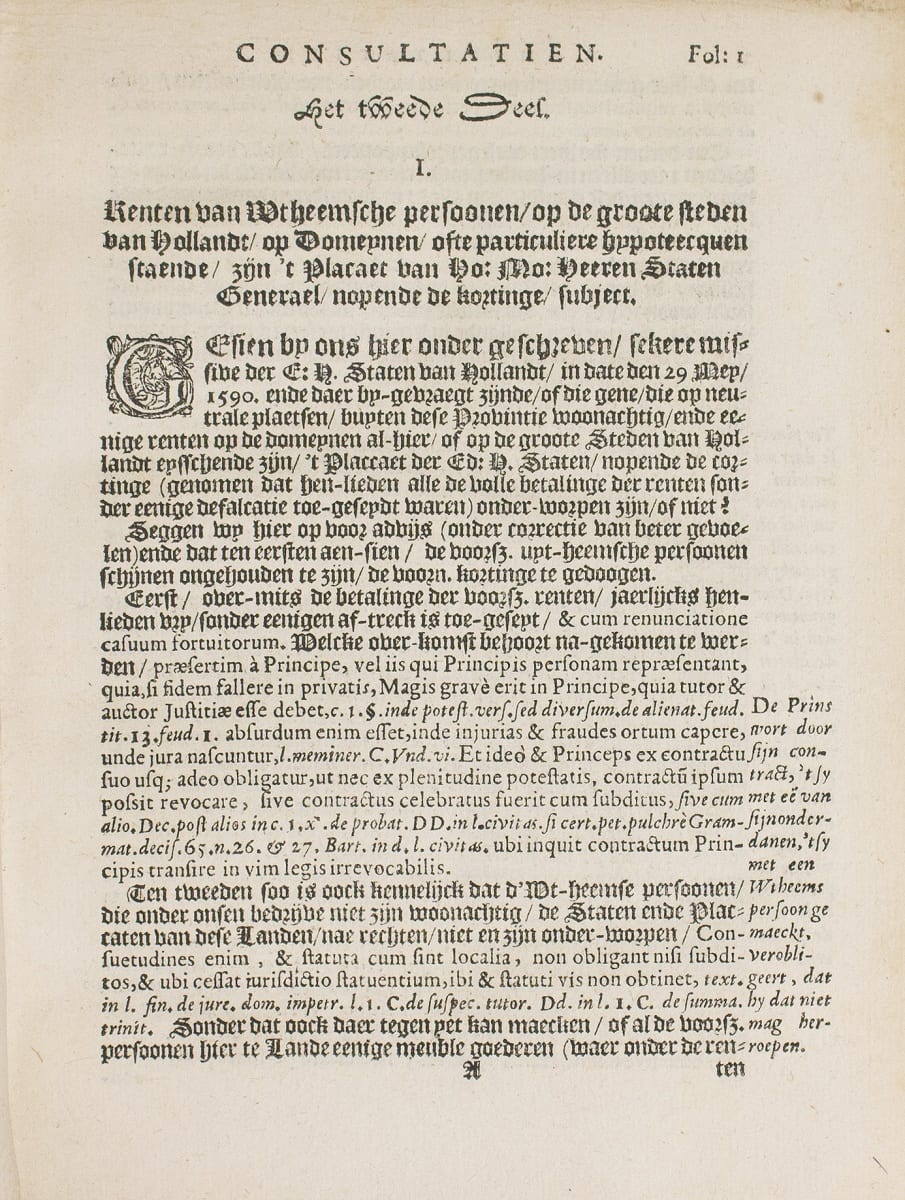 Consultatien, advysen en advertissementen gegeven ende geschreven by verscheyden treffelijcke rechts-geleerden in Hollandt.
Consultatien, advysen en advertissementen gegeven ende geschreven by verscheyden treffelijcke rechts-geleerden in Hollandt.
(Rotterdam: Joannes Naeranus, 1645-85).
Comprised of six volumes, the second of which is displayed here, the Consultatien is a well-known collection of legal opinions. Most notable are the opinions of Hugo de Grotius, which reflect the work of the early Roman-Dutch jurists to synthesize the texts of the Digest, Dutch customary law, and decisions of foreign courts into a cohesive body of legal opinion.
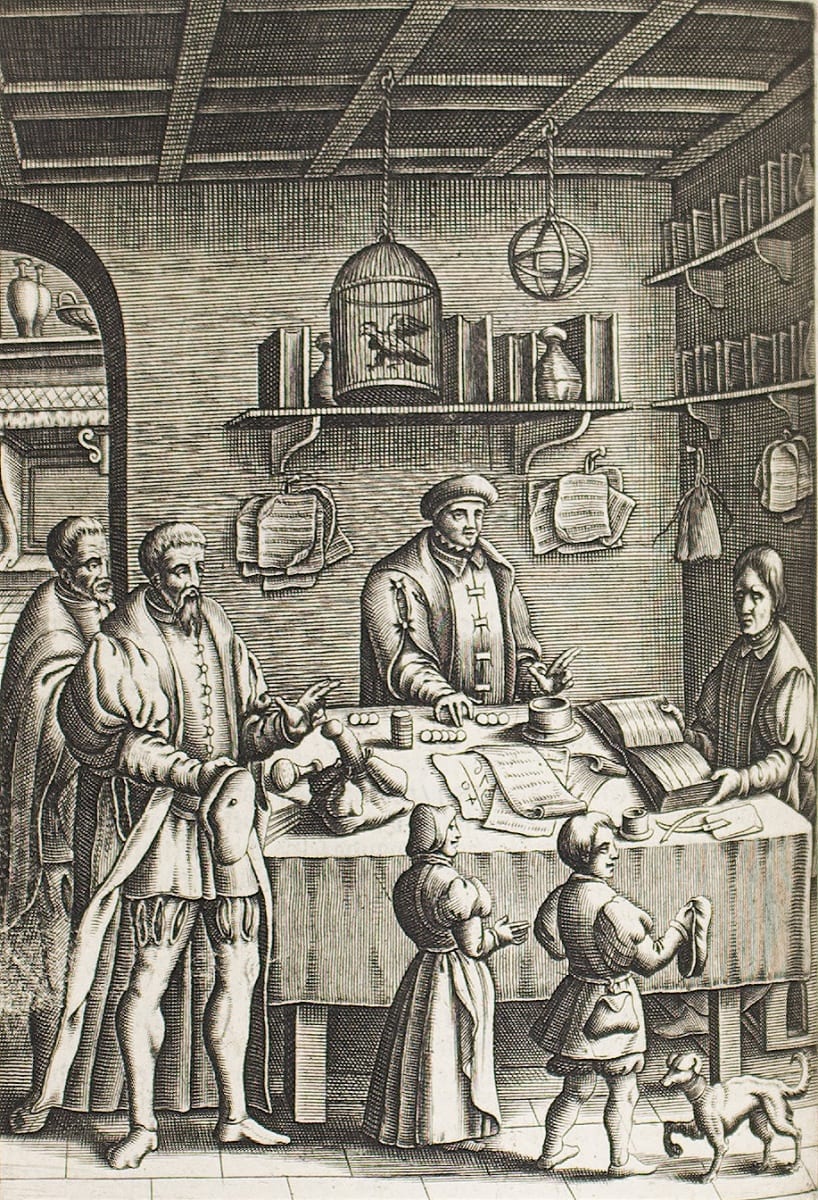 Joost de Damhoudere. Practycke in criminele saken…
Joost de Damhoudere. Practycke in criminele saken…
(Rotterdam: Pieter van Waesberge, 1650).
Joost de Damhouder’s 1554 manual of criminal law and procedure was well-known not only in the Netherlands, but throughout Europe in Latin, French, and German translations. Additionally, it was popular for its woodcut engravings depicting crimes and punishments. The work was almost wholly plagiarized from a c.1508 work by the Flemish jurist, Filips Wielant. While treating Dutch customary law, the work nonetheless incorporates the principles and terminology of Roman law and reflects the influence of the Bartolist tradition.
Antonius Matthaeus. De criminibus ad lib. XLVII. et. XLVIII. Dig. commentarius Antonii Matthaei IC…
(Utrecht: Ioannis à Waesberge, 1644).
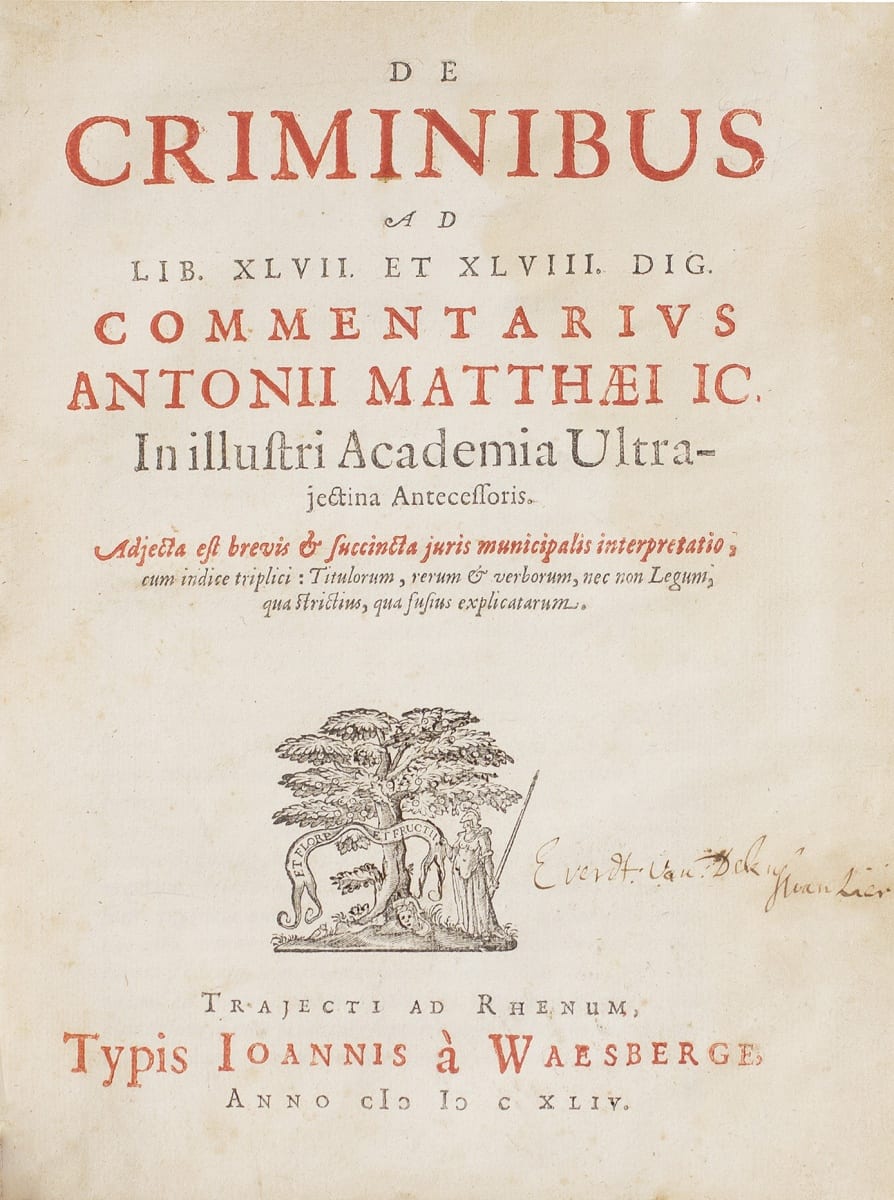 One of the Roman-Dutch jurists of the “Elegant School” of the late seventeenth and eighteenth centuries, Antonius Matthaeus is best known for his work on Roman criminal law. Focusing on the nature of crime in De criminibus, Matthaeus set forth arguments for the distinction between criminal, or wrongful acts serious enough to require criminal rather than civil action, and delicta, which can rise to a criminal or civil action. Within this framework, Matthaeus thus navigated between the Roman law of delict, which tended to emphasize the civil action as a remedy, and the custom in later European law to treat wrongful acts, such as robberies and thefts, primarily as crimes. This original edition of De Criminibus from 1644 was the first of at least ten reprinted editions within a century.
One of the Roman-Dutch jurists of the “Elegant School” of the late seventeenth and eighteenth centuries, Antonius Matthaeus is best known for his work on Roman criminal law. Focusing on the nature of crime in De criminibus, Matthaeus set forth arguments for the distinction between criminal, or wrongful acts serious enough to require criminal rather than civil action, and delicta, which can rise to a criminal or civil action. Within this framework, Matthaeus thus navigated between the Roman law of delict, which tended to emphasize the civil action as a remedy, and the custom in later European law to treat wrongful acts, such as robberies and thefts, primarily as crimes. This original edition of De Criminibus from 1644 was the first of at least ten reprinted editions within a century.
Everard van Bronkhorst. Ever. Bronchorst. j.c. In titulum Digestorum De diversis regulis juris antiqui enarrationes.
(Amsterdam: Aegidium Janssonium Valckenier, 1657).
Everard van Bronkhorst. Euerardi Bronchorst i.c. Centuriae duae enantiophanōn et conciliationes eorundem, iuxta seriem Pandectarum dispositae.
(Leiden: Franciscum Raphelengium, 1595).
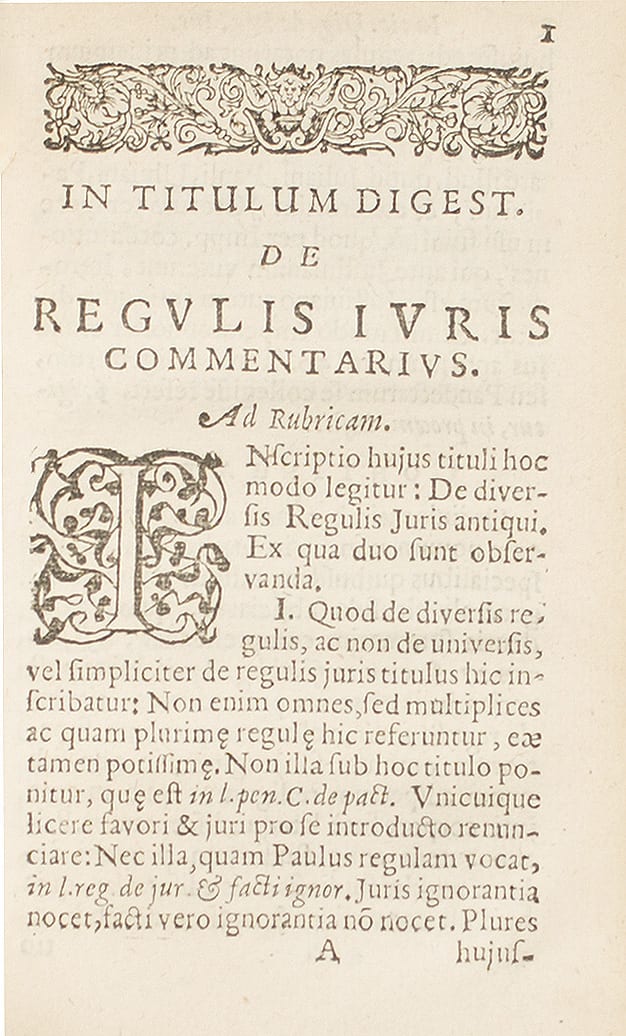
The epicenter of early modern Dutch legal studies was at Leiden, where Everard van Bronkhorst succeeded the great French humanist Donellus in 1587. Bronkhorst was fundamental in shaping the character of legal scholarship in the Dutch universities, which was a combination of what was known as the “elegant” and the “forensic” approaches to law—essentially a combination of the mos italicus and the mos gallicus. Bronkhorst’s approach put equal importance on law students’ preparedness for court practice and their knowledge of the underlying principles of law. In his teachings, he emphasized the Institutes and the last title of the Digest where these principles were found.
Hugo Grotius. Hugonis Grotii De iure belli ac pacis libri tres…
(Amsterdam: Joannem Blaeu, 1670).
Hugo de Groot, or Groitus, is regarded as the father of international law largely because of this classic work, On War and Peace, the first modern formulation of international law. First published in 1625, it argues that freedom depends on the rule of law, “the law of nations,” as developed by the collective will of sovereign states. While Grotius based his conception of international law upon a natural law separate from the civil law, his argumentation relies heavily on civil law texts, and the natural law he outlines might be seen as an extension of Roman civil law.
Hugo Grotius. Inleydinghe tot de Hollandsche rechts-gheleerdheydt: beschreven by Hugo de Groot…
(Haarlem: Adriaen Roman, 1636).
Willem Schorer. Aanteekeningen van Mr. Willem Schorer, over de Inleidinge tot de Hollandsche rechts-geleerdheid, van Mr. Hugo de Groot…
(Middelburg: Pieter Gillissen en Zoon, 1784-86).
The most famous Dutch jurist, Hugo Grotius, was a child prodigy who began his studies at Leiden at age eleven. Imprisoned for his part in a theological and political dispute, he used his time in prison to write the Inleyding, or Introduction to the Jurisprudence of Holland, first published in 1631. Treating Dutch law as its own system, the work incorporated both customary law and Roman law. Influenced by his education at Leiden by Donellus and the French humanists’ emphasis on the systematic approach of the Institutes, Grotius divided Dutch law, as the Institutes did Roman law, into the legal categories of persons, things and obligations. This 1767 edition is annotated by Willem Schorer, who followed with the 1777 Rechtsgeleerde observation and three other volumes of commentary on Grotius’ work, into which he attempts to incorporate the work of the later writers. Schorer was a lawyer, a prominent landowner from Zeeland, and a president of the Council of Flanders.
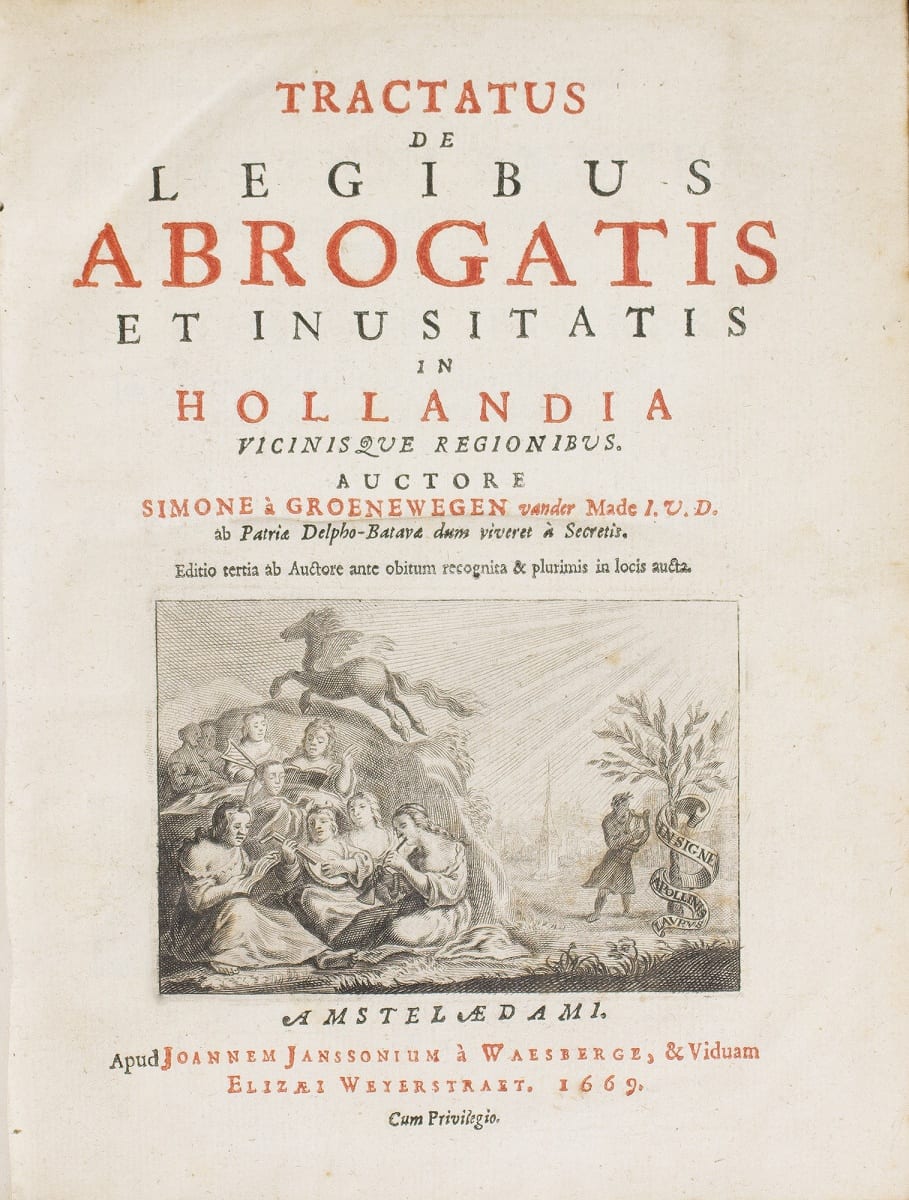 Simon à Groenewegen van der Made. Tractatus de legibus abrogatis et inusitatis in Hollandia vicinisque regionibus…
Simon à Groenewegen van der Made. Tractatus de legibus abrogatis et inusitatis in Hollandia vicinisque regionibus…
(Amsterdam: Joannem Janssonium à Waesberge, 1669).
Simon à Groenegewegen (1613-52), who annotated Hugo Grotius’ Inleyding, also produced this fundamental treatise for Dutch legal scholars and practitioners alike. First published in 1649, the Tractatus de legibus abrogatis et inusitatis was a systematic examination of the Corpus iuris civilis to determine which laws had fallen out of use or had been abrogated by Dutch legal custom and practice. It thus became a useful text for scholars and practitioners because it clearly demonstrated how the law had departed from Roman law at the time it was being applied.
Ulrik Huber. Heedensdaegse rechtsgeleertheyt: soo elders, als in Frieslandt gebruikelijk.
(Leeuwarden: Hero Nauta, 1699).
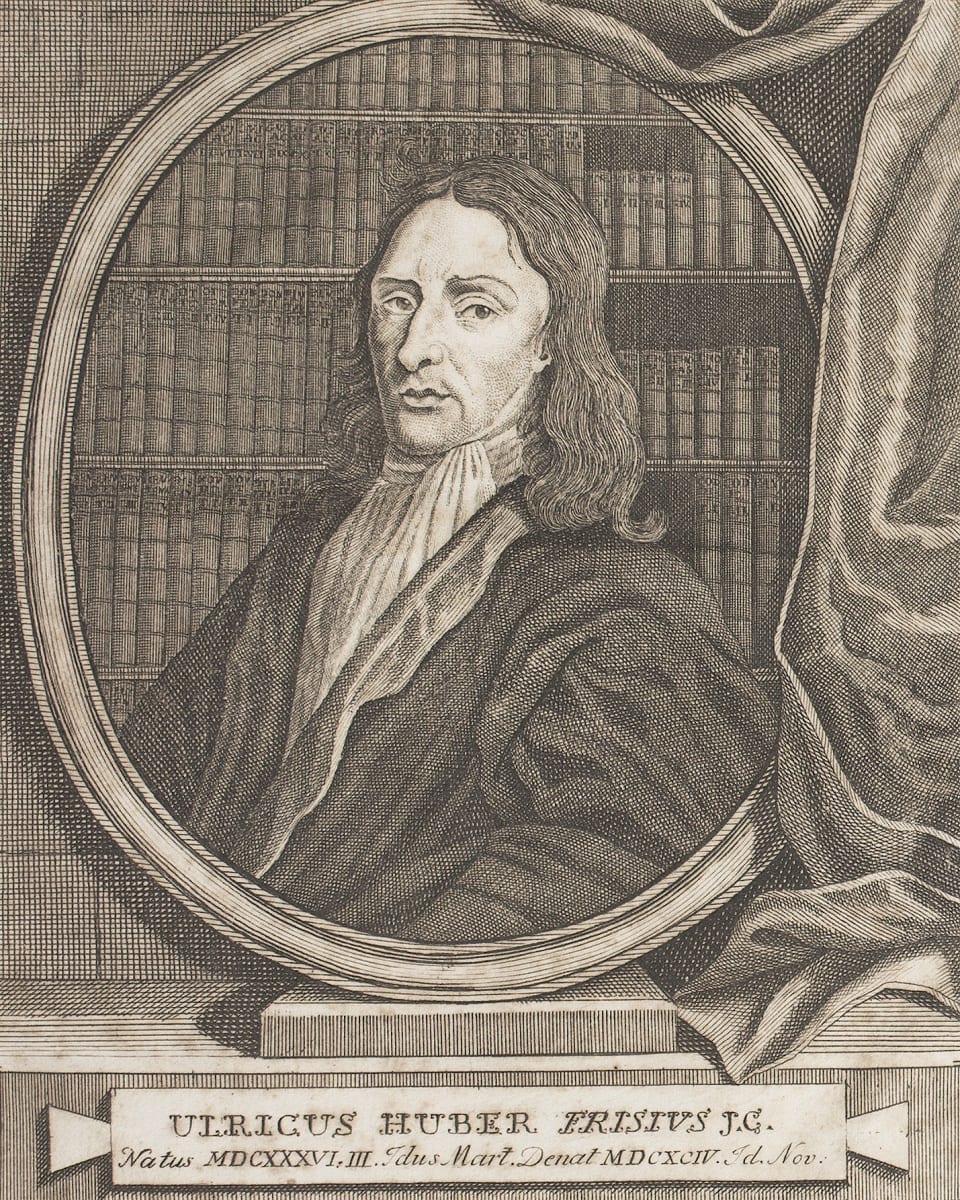 Ulrik Huber. Prælectionum juris civilis tomi tres secundum Institutiones et Digesta Justiniani…
Ulrik Huber. Prælectionum juris civilis tomi tres secundum Institutiones et Digesta Justiniani…
(Neapoli: Josephi et Joannis Roland, 1784-8).
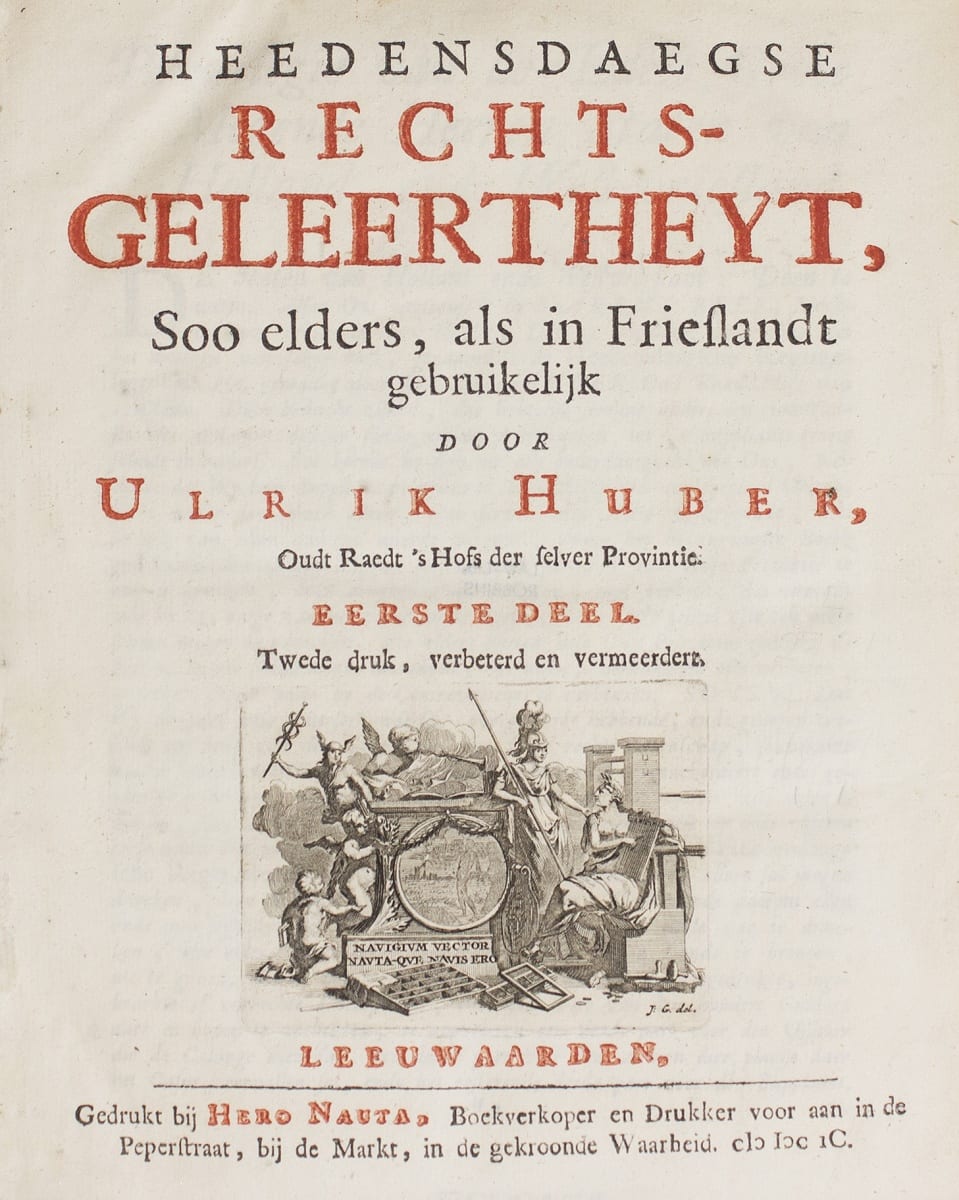 While Roman-Dutch law treated Roman law as it applied specifically to
While Roman-Dutch law treated Roman law as it applied specifically to 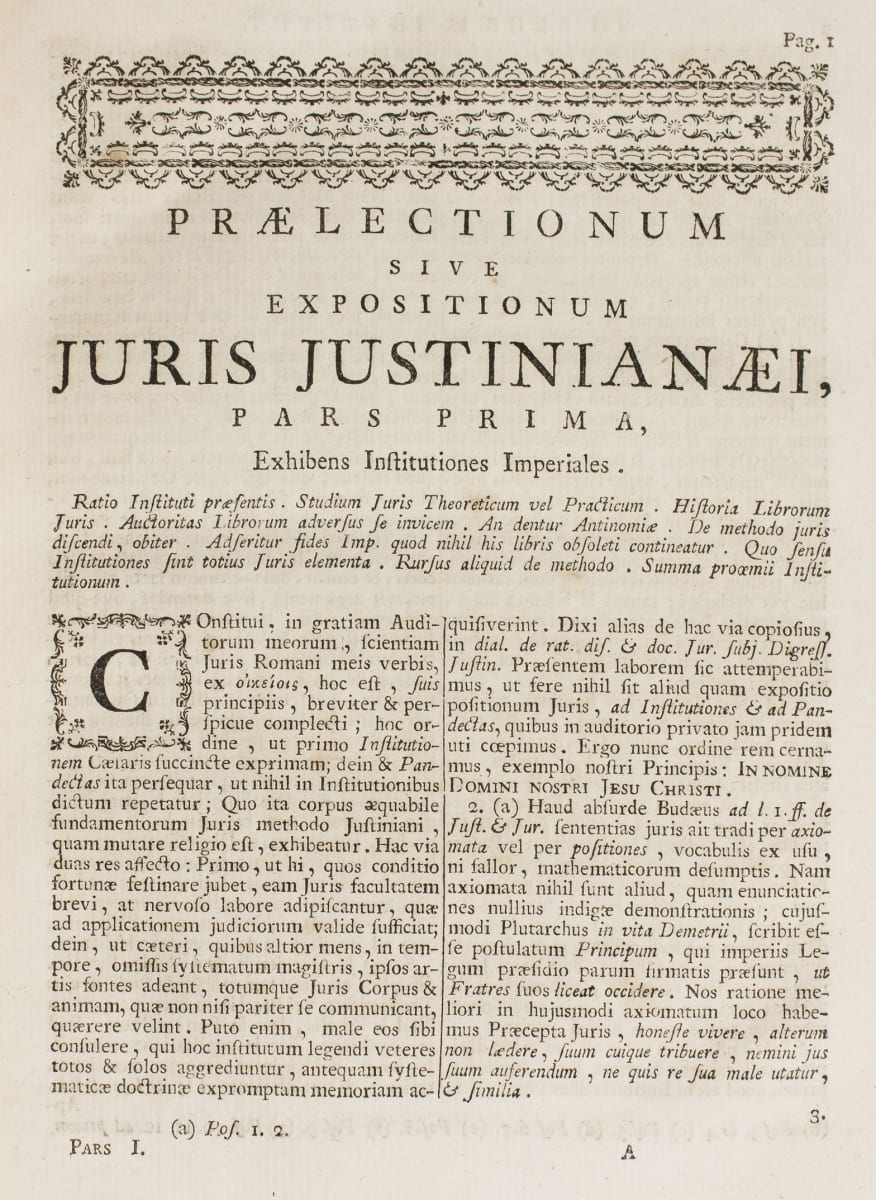 Holland rather than to the entire Dutch Republic, Holland was not the only Dutch province where Roman legal scholarship flourished in the early modern period. Ulrik Huber (1636-94) was the most famous jurist of the northern province of Friesland. A member of the Frisian court from 1679-82, Huber, along with the jurist Johannes van den Sande a half a century before him, came to represent a Roman-Frisian legal tradition known for its strict adherence to Roman law. “We adhere to the rule that, save in so far as the position is clearly otherwise under Frisian law, it remains as prescribed by the laws of Rome,” wrote Huber in Heedensdaegse rechtsgeleertheyt. Influenced by Grotius’ Inleydinghe, Heedensdaegse offered a detailed survey of Frisian law and its social context. Huber’s other major work, Prælectionum juris civilis, used Roman sources to introduce the modern discipline of conflict of laws.
Holland rather than to the entire Dutch Republic, Holland was not the only Dutch province where Roman legal scholarship flourished in the early modern period. Ulrik Huber (1636-94) was the most famous jurist of the northern province of Friesland. A member of the Frisian court from 1679-82, Huber, along with the jurist Johannes van den Sande a half a century before him, came to represent a Roman-Frisian legal tradition known for its strict adherence to Roman law. “We adhere to the rule that, save in so far as the position is clearly otherwise under Frisian law, it remains as prescribed by the laws of Rome,” wrote Huber in Heedensdaegse rechtsgeleertheyt. Influenced by Grotius’ Inleydinghe, Heedensdaegse offered a detailed survey of Frisian law and its social context. Huber’s other major work, Prælectionum juris civilis, used Roman sources to introduce the modern discipline of conflict of laws.
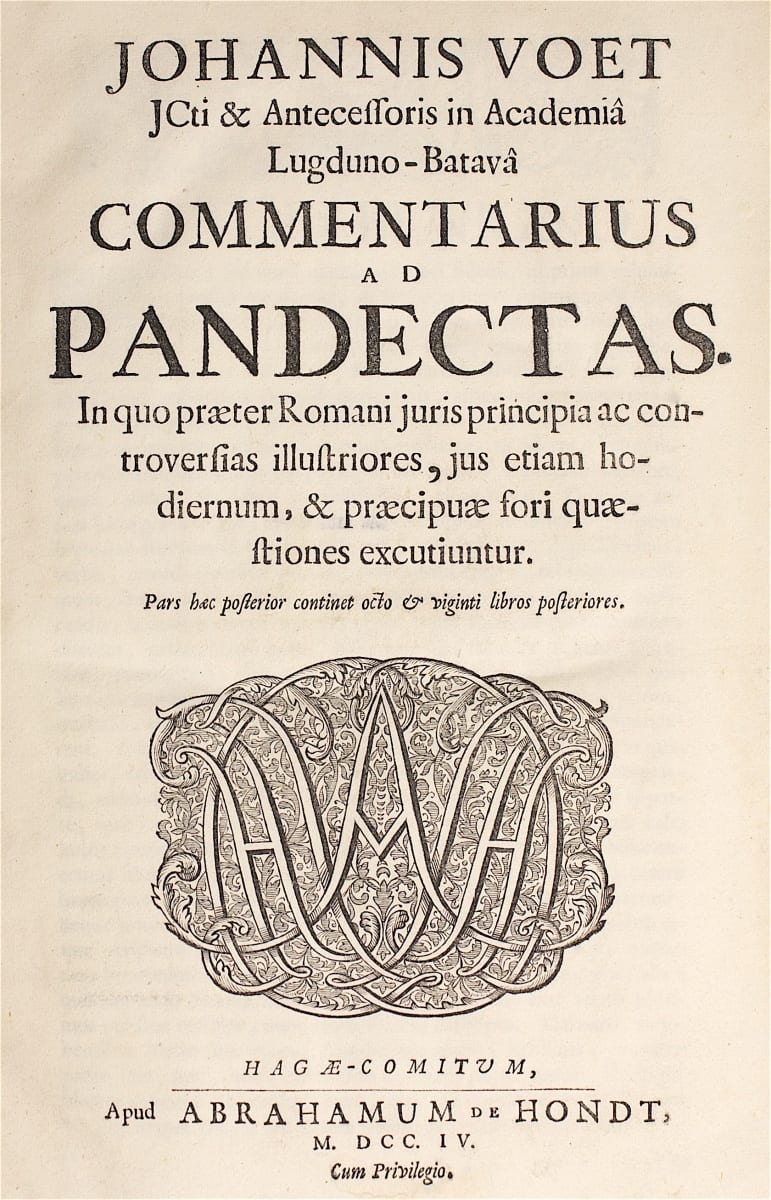 Johannes Voet. Commentarius ad Pandectas: in quo praeter Romani juris principia ac controversias illustriores, jus etiam hodiernum, & praecipuae fori quaestiones excutiuntur.
Johannes Voet. Commentarius ad Pandectas: in quo praeter Romani juris principia ac controversias illustriores, jus etiam hodiernum, & praecipuae fori quaestiones excutiuntur.
(The Hague: Abrahamum de Hondt, 1698-1704).
Voet is known for his masterful and meticulously compiled collection of commentaries on Justinian’s Digesta. Voet’s commentaries brought together and systemized the work of earlier generations, and his seventeenth century contemporaries, into a large two-volume work originally published between 1698-1704. Voet’s compilation followed the Digest’s original arrangement by title, but within each title divided the explanation and commentary between the first Roman law and then the modern law, giving full citations for each. The completeness and organization of Voet’s treatise made it one of the most important reference works produced by the Roman-Dutch school.
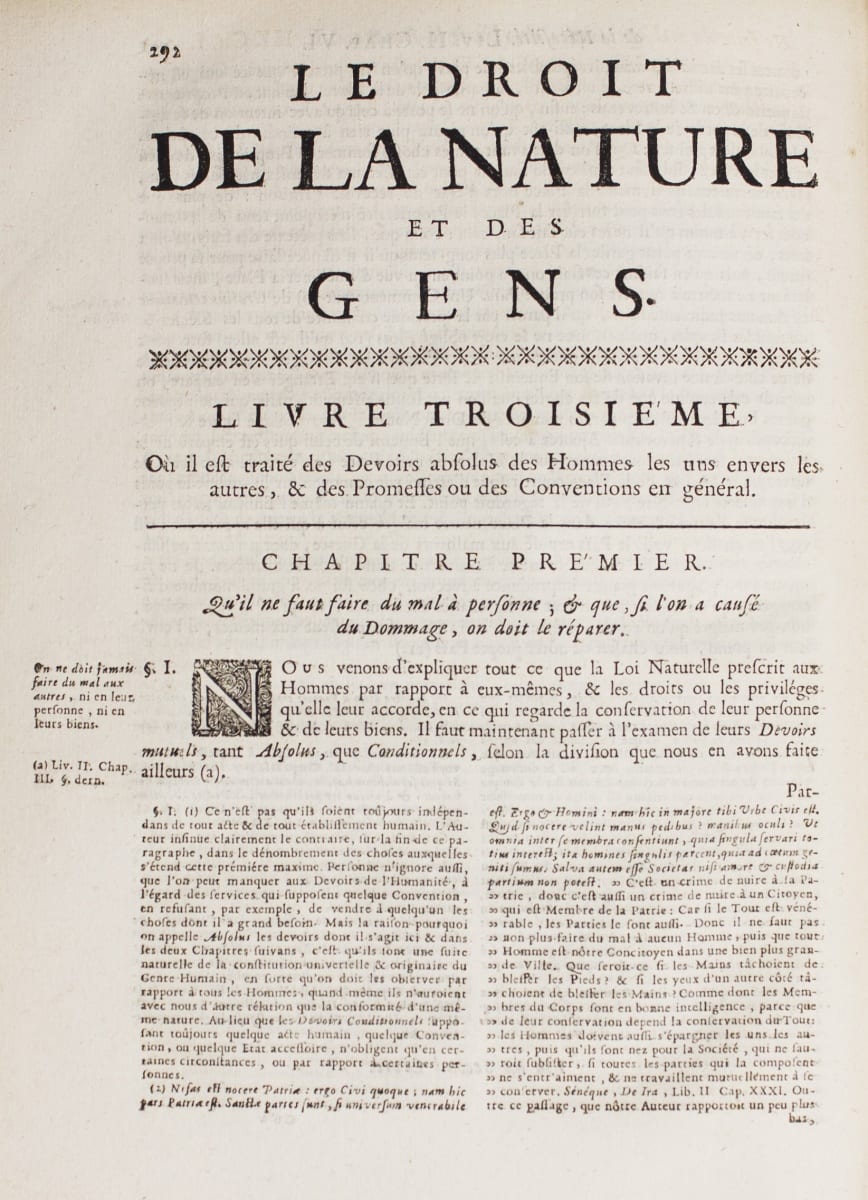 Samuel Freiherr von Pufendorf. Le droit de la nature et des gens, ou, Systeme general des pincipes les plus importans de la morale, de la jurisprudence, et de la politique…
Samuel Freiherr von Pufendorf. Le droit de la nature et des gens, ou, Systeme general des pincipes les plus importans de la morale, de la jurisprudence, et de la politique…
(Amsterdam: Chez la Veuve de Pierre de Coup, 1734).
German scholar Samuel von Pufendorf is known for his commentaries on the work of Grotius and Hobbes, as well as his own theories on natural law and the law of nations. His first major treatise, Elementa jurisprudentiae universalis, presented a system of universal law based upon the ideas of Grotius and Hobbes and was published at Leiden in 1661. The work displayed here is a French translation of his De jure naturae et gentium (1672), a later work in which he expounds more thoroughly on Grotius’ theories on natural law and extends them with his own and Hobbes’ ideas. Though not focused on Roman-Dutch legal scholarship, Pufendorf’s work was closely associated with that of Grotius and was thus an important influence on legal humanistic studies in the Netherlands and throughout Europe during the seventeenth and eighteenth centuries.
Simon van Leeuwen. Censura forensis theoretico-practica: id est Totius jurius civilis Romani, usuque recepti, & practici methodica collatio…
(Amsterdam: Henricum & Theodorum Boom, 1678).
Simon van Leeuwen. Simon van Leeuwen’s Censura forensis, translated into English.
(Cape Town: J.C. Jutta, 1884-96).
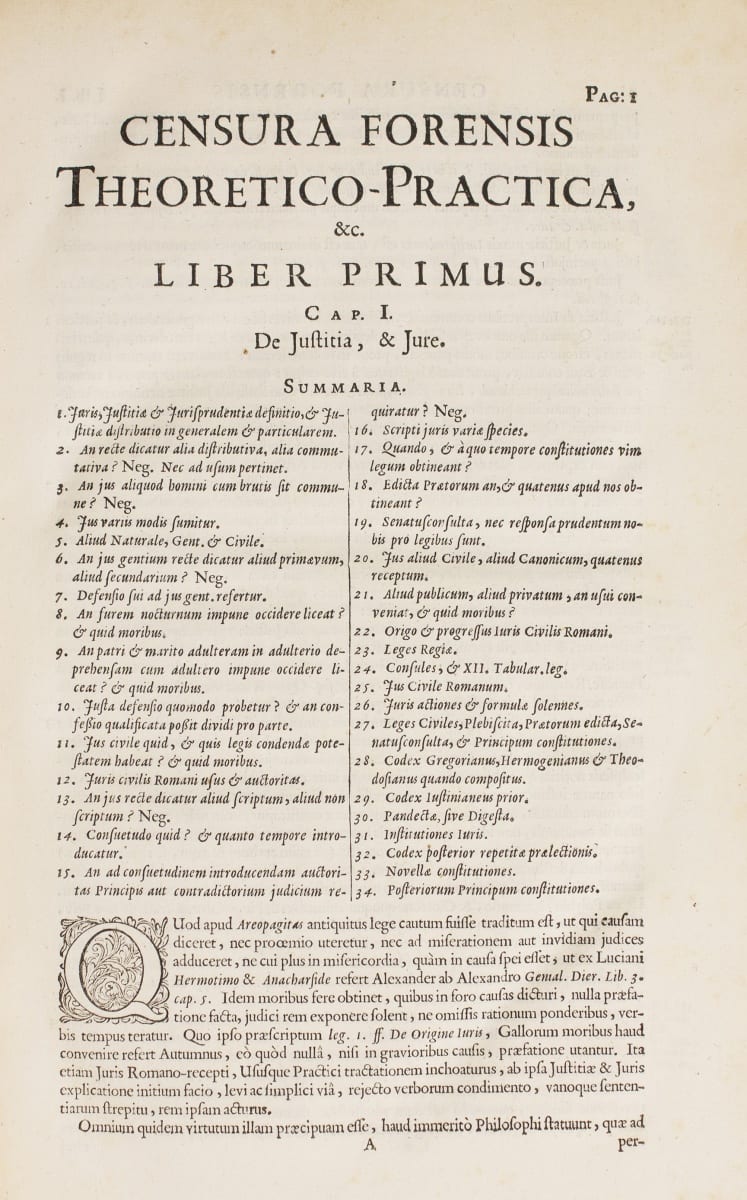 Seventeenth century scholar SimonVan Leeuwen (1625/26-82) is perhaps most famous for coining the phrase “Roman-Dutch law” in his 1664 work, Het Roomsch-Hollandsch Recht. In Censura forensis, he attempted to systematize the entire civil law encompassing Roman, Dutch, and foreign law. The English translation of Censura forensis, published at the end of the nineteenth century, reflects Van Leeuwen’s prominence, along with Voet, Grotius, Huber, D.G. van der Keessel, and Johannes van der Linden, as the frequently cited “old authorities” of Roman-Dutch law in court decisions in South Africa and Sri Lanka (formerly Ceylon). The Roman-Dutch tradition has remained a source of law in these former Dutch colonies to present day, long after it was superseded in the Netherlands itself by the 1809 codification of Dutch law based on the French Civil Code.
Seventeenth century scholar SimonVan Leeuwen (1625/26-82) is perhaps most famous for coining the phrase “Roman-Dutch law” in his 1664 work, Het Roomsch-Hollandsch Recht. In Censura forensis, he attempted to systematize the entire civil law encompassing Roman, Dutch, and foreign law. The English translation of Censura forensis, published at the end of the nineteenth century, reflects Van Leeuwen’s prominence, along with Voet, Grotius, Huber, D.G. van der Keessel, and Johannes van der Linden, as the frequently cited “old authorities” of Roman-Dutch law in court decisions in South Africa and Sri Lanka (formerly Ceylon). The Roman-Dutch tradition has remained a source of law in these former Dutch colonies to present day, long after it was superseded in the Netherlands itself by the 1809 codification of Dutch law based on the French Civil Code.
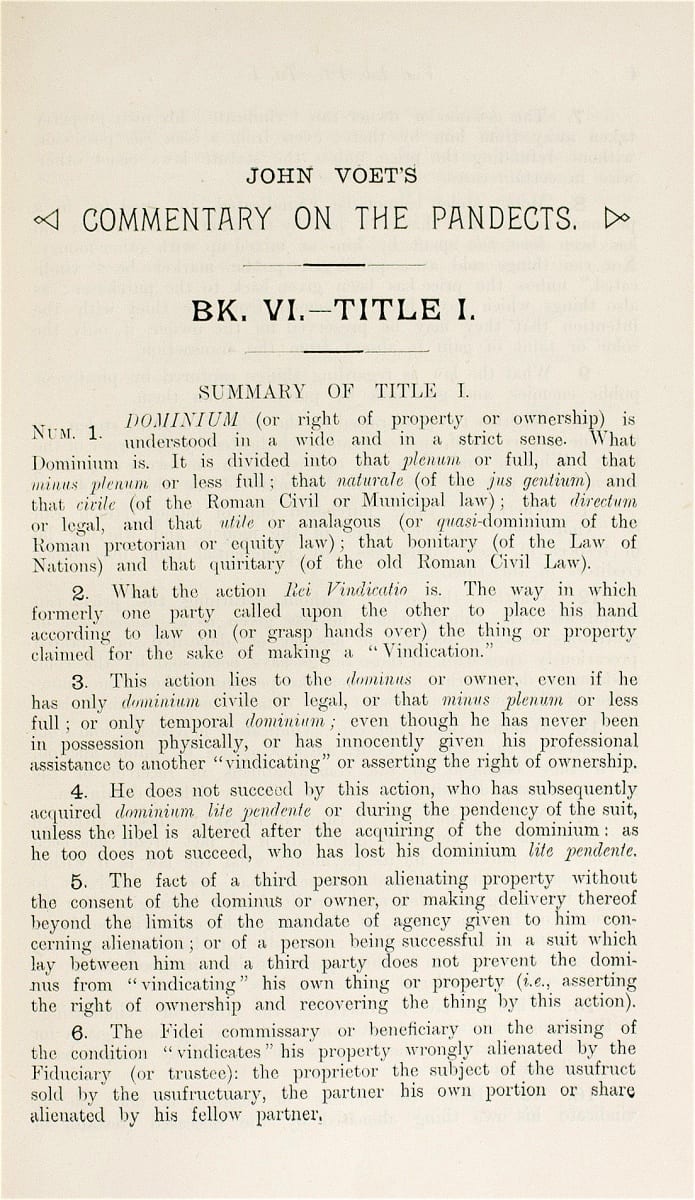 Johannes Voet. Voet’s titles on vindicationes & interdicta, translated into English.
Johannes Voet. Voet’s titles on vindicationes & interdicta, translated into English.
(Colombo: Ceylon Observer, 1893).
The systematic thoroughness of Voet’s Commentarius ad Pandectas, which compiled classical and modern commentary pertaining to each title of Justinian’s Digest, have made him the Roman-Dutch jurist most highly regarded and frequently consulted by the modern South African and Sri Lankan courts. This late nineteenth century edition–translated into English by John J. Casie Chitty and published in Colombo, Sri Lanka (formerly Ceylon)–focuses on Voet’s examination of some specific titles from the Digest.
Antonius Matthaeus. On Crimes: a Commentary on Books XLVII and XLVIII of the Digest.
(Cape Town: Juta, 1987-96).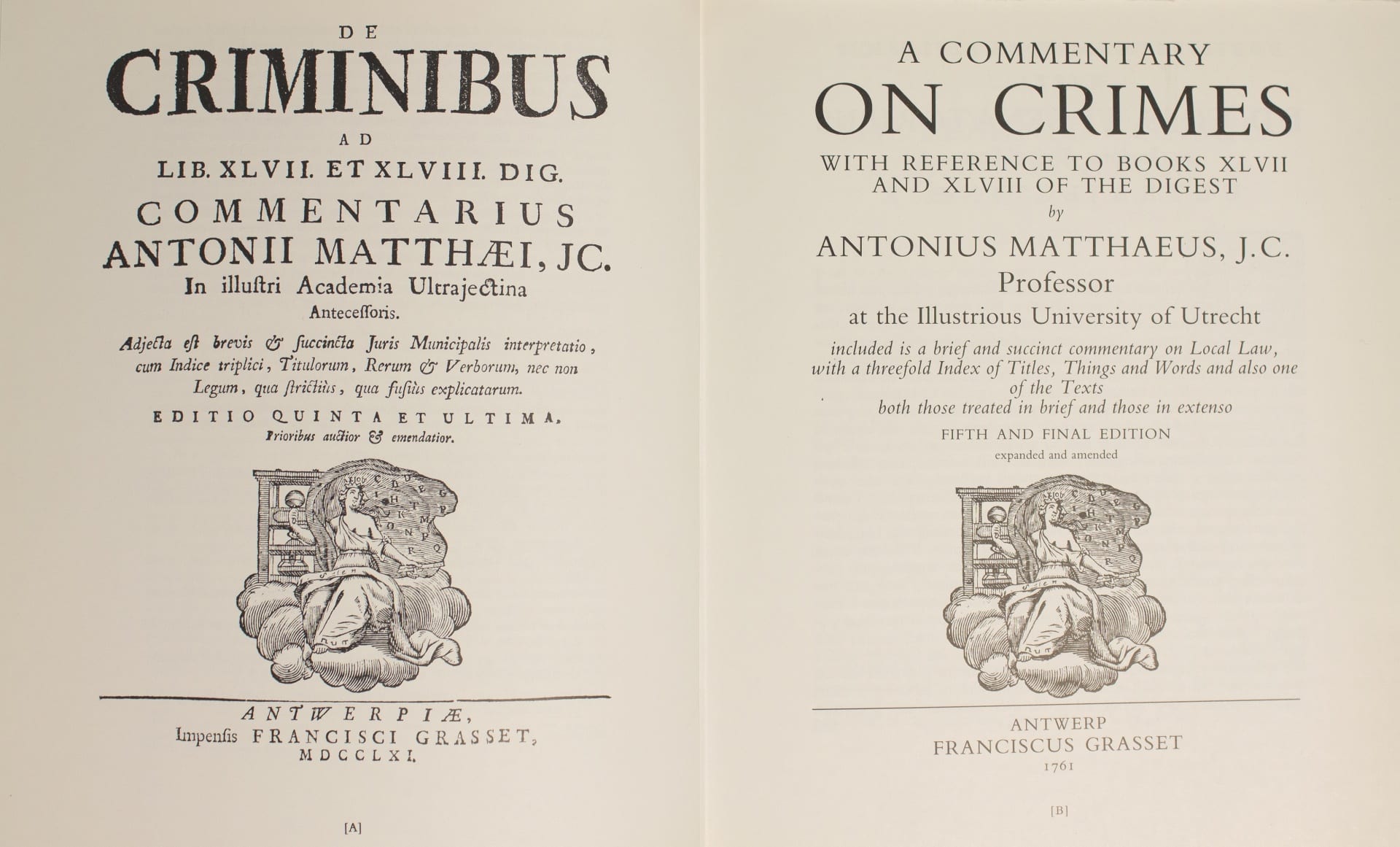
This facsimile reproduction and translation of the 1761 edition by South African legal scholar M.L. Hewett is another example of the continued relevance of early modern Roman-Dutch authorities to the contemporary study of South African law and the ongoing use of these works in modern legal theory and practice.
Hugo Grotius. Inleydinge tot de Hollandsche rechts-geleertheyt; Interleaved with a manuscript transcription of Johannes Voet’s Observationes ad Hugonis Grotii manudictionem, and other notes
(Amsterdam: Jan Boom, 1727).
T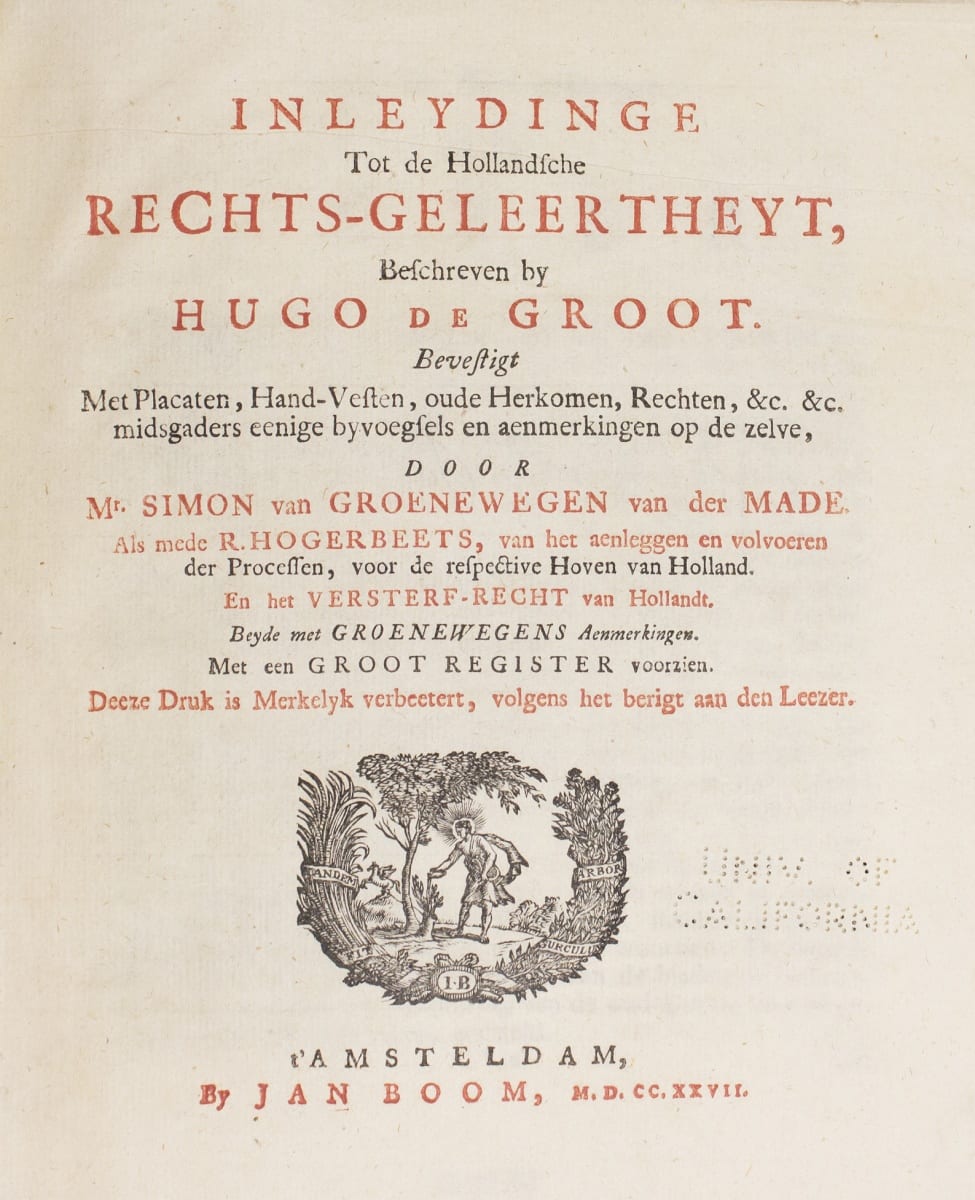 his copy of the Groenewegen edition of Hugo Grotius’s Inleydinge came to the Robbins Collection from the estate of James de Fremery, Consul General to the Netherlands in San Francisco from 1863-91. The copy belonged to James de Fremery’s father, Jacobus Petrus de Fremery, who studied law as a young man. The original edition was disbound and rebound interleaving the original with blank pages for notes, which have been added in two stages. First, was the addition of Johanness Voet’s Observationes– originally dictated by Voet and written down by his students, thereafter taking on a life of their own as commentaries to the text. The second was the addition of notes in Dutch, presumably by the elder Fremery. Law students of today, and even from the nineteenth century, will particularly appreciate the practice of disbanding textbooks and interleaving them with their own notes.
his copy of the Groenewegen edition of Hugo Grotius’s Inleydinge came to the Robbins Collection from the estate of James de Fremery, Consul General to the Netherlands in San Francisco from 1863-91. The copy belonged to James de Fremery’s father, Jacobus Petrus de Fremery, who studied law as a young man. The original edition was disbound and rebound interleaving the original with blank pages for notes, which have been added in two stages. First, was the addition of Johanness Voet’s Observationes– originally dictated by Voet and written down by his students, thereafter taking on a life of their own as commentaries to the text. The second was the addition of notes in Dutch, presumably by the elder Fremery. Law students of today, and even from the nineteenth century, will particularly appreciate the practice of disbanding textbooks and interleaving them with their own notes.
Tambyah Nadaraja. The Roman-Dutch law of fideicommissa as applied in Ceylon and South Africa.
(Colombo: Associated Newspapers of Ceylon, 1949).
In modern Sri Lanka, which became an independent state in 1948 after more than two centuries of Dutch and then British colonial rule, private and family law is still governed primarily by Roman-Dutch law, as well as, Muslim law and indigenous Sinhalese and Tamil customary law. English common law dominates commercial and public law, in addition to the administration of justice. As highlighted in this work on the law of fideicommissa, or trusts, published in the newly-independent Sri Lanka in 1949, the continued authority of Roman-Dutch law in Sri Lanka, as in South Africa, has been the strongest in matters of law such as inheritance, marriage, and divorce—all central areas of law in the classical Roman law tradition.
06/26/17
